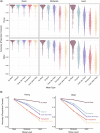Face mask type affects audiovisual speech intelligibility and subjective listening effort in young and older adults
- PMID: 34275022
- PMCID: PMC8286438
- DOI: 10.1186/s41235-021-00314-0
Face mask type affects audiovisual speech intelligibility and subjective listening effort in young and older adults
Abstract
Identifying speech requires that listeners make rapid use of fine-grained acoustic cues-a process that is facilitated by being able to see the talker's face. Face masks present a challenge to this process because they can both alter acoustic information and conceal the talker's mouth. Here, we investigated the degree to which different types of face masks and noise levels affect speech intelligibility and subjective listening effort for young (N = 180) and older (N = 180) adult listeners. We found that in quiet, mask type had little influence on speech intelligibility relative to speech produced without a mask for both young and older adults. However, with the addition of moderate (- 5 dB SNR) and high (- 9 dB SNR) levels of background noise, intelligibility dropped substantially for all types of face masks in both age groups. Across noise levels, transparent face masks and cloth face masks with filters impaired performance the most, and surgical face masks had the smallest influence on intelligibility. Participants also rated speech produced with a face mask as more effortful than unmasked speech, particularly in background noise. Although young and older adults were similarly affected by face masks and noise in terms of intelligibility and subjective listening effort, older adults showed poorer intelligibility overall and rated the speech as more effortful to process relative to young adults. This research will help individuals make more informed decisions about which types of masks to wear in various communicative settings.
Keywords: Aging; Face masks; Speech intelligibility; Subjective listening effort.
© 2021. The Author(s).
Conflict of interest statement
The authors declare that they have no competing interests.
Figures



References
-
- Brumm H, Zollinger SA. The evolution of the Lombard effect: 100 years of psychoacoustic research. Behaviour. 2011;148(11–13):1173–1198. doi: 10.1163/000579511X605759. - DOI
-
- Bürkner P-C. brms: An R Package for Bayesian multilevel models using Stan. Journal of Statistical Software, Articles. 2017;80(1):1–28.
Publication types
MeSH terms
Grants and funding
LinkOut - more resources
Full Text Sources
Miscellaneous
